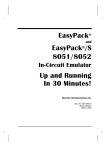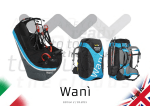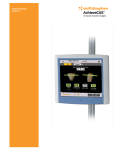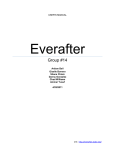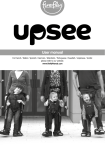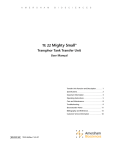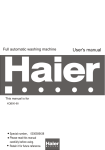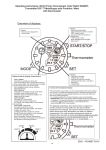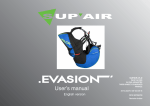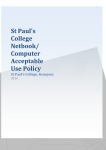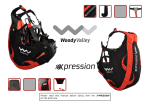Download User manual
Transcript
LIGHTNESS User manual Edition 05-2010 2 Contents The LIGHTNESS............................................................................... 4 Welcome on board!....................................................................... 4 Outstanding features of the LIGHTNESS...................................... 4 More important details.................................................................. 5 The X-ALPS Team......................................................................... 5 Safety advice.................................................................................... 6 General advice about paragliding................................................ 6 Handle with Care.............................................................................. 7 Preparing the products..................................................................... 8 Delivery......................................................................................... 8 Installing the comfort foam............................................................ 9 Fitting the speedbag................................................................... 10 Adjusting the harness..................................................................11 Fitting the speed system..............................................................17 Attaching the instrument panel................................................... 18 Packing and fitting the reserve................................................... 19 Setting up the rucksack.............................................................. 23 Using the LIGHTNESS.................................................................... 25 Flying with the LIGHTNESS........................................................ 25 Walking with the LIGHTNESS..................................................... 25 Packing the rucksack.................................................................. 26 Packing the back and under-seat pockets................................. 27 Attaching the reserve.................................................................. 28 Throwing the reserve................................................................... 29 Using the speedbag.................................................................... 29 Using the speed system............................................................. 29 Other uses................................................................................... 30 Maintenance, repairs and service intervals................................... 32 Care and maintenance................................................................ 32 Check.......................................................................................... 33 Repairs........................................................................................ 33 Disposal...................................................................................... 33 Technical details............................................................................. 34 Technical Data............................................................................. 34 Materials used............................................................................. 35 Certification................................................................................. 35 Service............................................................................................ 36 ADVANCE Service Center.......................................................... 36 The ADVANCE website............................................................... 36 Warranty...................................................................................... 36 Overview of components............................................................... 38 3 The LIGHTNESS Welcome on board! LIGHTNESS stands for an extremely light and very comfortable reclining harness with speedbag, together with its own lightweight rucksack. Both items go perfectly together and the resulting refined and compact unit weighs about 3 kg. The LIGHTNESS is best suited to cross-country Hike & Fly pilots, travellers and bivouac flyers. Outstanding features of the LIGHTNESS Tried and tested in the X-Alps vision means that the harness can be adapted to every individual’s requirements, and the whole body is perfectly supported. The exceptionally compact rucksack provides excellent carrying comfort. Uncompromisingly light and well thought out Thanks to the workmanship shown on the highest quality lightweight materials, and a convincingly simple concept, the harness with speedbag, front container, instrument panel and comfort foam weighs around 2.3 kg; the rucksack 700g. This means that, without resorting to a light wing, all your equipment can add up to only just over 10 kg - helmet and light reserve included. The unique LIGHTNESS concept carries the spirit of the X-Alps with it and brings to life again the original idea of free flight - to attain the necessary metres on foot, then make the most of their potential in flight. The ADVANCE X-Alps team have tested the LIGHTNESS products through and through, and Chrigel Maurer won the hardest paraglider race in the world with it. Top comfort – in the air and on the ground The harness does not have a seatboard and therefore fits the body perfectly. The comfortable hammock principle gives an even more direct feedback from wing to pilot. The comprehensive adjustment pro4 More important details The X-ALPS Team • The harness is fitted with the proven ADVANCE two-buckle inte grated chest and leg strap fastening system (equivalent to the Safe-T-System). • The adjustable-sized front container can accommodate a normal size round reserve. • The instrument panel easily attaches to the chest strap. • An additional pocket is provided under the seat area. • The accelerate system has ball-bearing pulleys. • The harness and rucksack have the stylish ADVANCE look: classy, clear and elegant. Chrigel Maurer won the hardest paraglider race in the world, the 2009 Red Bull X-Alps from Salzburg to Monaco. He reached the finish line in less than ten days, with a lead of 180 kilometres. Heli Eichholzer (A) and Ramon Morillas (E) were the other ADVANCE team pilots in the race. During the X-Alps all the ADVANCE pilots relied on the LIGHTNESS products developed by Chrigel and his team. Preparations for the X-Alps also became the development phase of the original LIGHTNESS, and Chrigel travelled countless kilometres with it in flights of up to ten hours. Chrigel’s story: In this manual Chrigel Maurer gives you background information and useful tips about managing and using the LIGHTNESS harness and its rucksack. 5 Safety advice Paraglider harnesses, like all commercially available reserve parachutes, are not at all suitable for free fall because of their construction. The reserve parachute and its connection to the harness are not designed to withstand an abrupt opening. All harness adjustments should definitely be made before flight. Correct adjustment contributes significantly to harness function, safety and comfort in flight. The foam in the harness seat area, in this manual referred to as comfort foam, does not provide protection from injury. When carrying out safety training over water you should be aware that the comfort foam floats in water and can put the pilot in a head down attitude. General advice about paragliding Flying a paraglider calls for appropriate training and a sound knowledge of the subject, as well as, of course, the necessary insurance cover and licence. A pilot must be able to correctly assess the weather conditions before taking off. His or her capabilities must be adequate for the actual paraglider. Wearing an adequate helmet, suitable boots and clothing, and carrying an emergency parachute are essential. Before every flight all items of equipment should be checked for damage and airworthiness. A proper pre-takeoff check must also be carried out. Every pilot bears sole responsibility for all the risks associated with participation in the sport of paragliding, including injury and death. Neither the manufacturer nor the seller of the equipment can guarantee or be held responsible for the pilot’s safety. 6 Handle with Care ADVANCE LIGHTNESS products are extremely lightly built and intended for specialised use. This puts particularly high demands on their handling and care. A committed interest in the products and their characteristics is essential. Because of the choice of materials and construction rucksack and harness are much more vulnerable to wear and tear from improper use than regular ADVANCE products. Caution: ADVANCE thinks it is important that you are aware of and sympathetic to the lightweight fabrics in the LIGHTNESS products. You can enjoy the harness and rucksack for a long time – but only if you look after them carefully. The label ‘Handle with Care’ is there to remind you that the lifespan of these products depends very much on your own care and attention. The LIGHTNESS products should never be dragged over the ground. All the zip fasteners are intended for light duty only and should never be closed under tension. Do not put pointed or sharp objects in the back pocket, the under-seat pocket or the rucksack – they could damage the material. Chrigel’s story: My equipment had to last as far as Monaco, even though I was in a hurry. I was very careful with it in training as well as during the race. I like to compare it with a narrow wheeled racing bike, which you would never take on a dirt road or through the woods. 7 Preparing the products Delivery Package Contents Before the delivery of every ADVANCE product the dealer has to check that the delivery package is complete, and that the basic settings are correct. The fully completed warranty form will ensure that defects in the product attributable to manufacturing faults are covered by the ADVANCE warranty (see Warranty in the section “Service”). The LIGHTNESS harness package contains: • Harness and speedbag with carbon footboard • LIGHTPACK rucksack • Reserve front container with release handle and Y-connection • Instrument panel • Comfort foam for the seat area • 2 alu carabiners • Speed line with 2 brummel hooks • Booklet ‘Getting started’ The LIGHTNESS harness is delivered with the comfort foam installed and the speedbag fitted, including the footboard and speed line. The four speedbag lines are already connected to the harness and the footboard serves as a foot stirrup. All straps and speedbag lines are adjusted to their standard settings when delivered. 8 Installing the comfort foam The comfort foam has already been installed in its pocket under the seat area at delivery. 9 Fitting the speedbag The four speedbag lines are already connected to the harness at delivery. To fit a replacement speedbag proceed as follows. Attach the speedbag Velcro to the corresponding part on the back of the harness and do up the zip fasteners completely. Hang the coloured speedbag loops over the main carabiners. For the stirrup function: connect the lower footboard lines to the corresponding lines from the end of the seat surface of the harness using anchor knots, and locate these on the existing overhand knots (kite knot). Connect the two upper lines from the footboard to their counterparts running from the main suspension points. The speedbag closure system ends in a loop which is put over the plastic ball for flight. Stretching the legs into the flying position after takeoff automatically closes the top of the speedbag. Info: Foot support is built into the speedbag for weight-saving reasons, and is essential for supporting the pilot in the reclining position. The LIGHTNESS harness only works with the speedbag. The speedbag is detachable for repairs or exchange. 10 Adjusting the harness The LIGHTNESS has many adjustment possibilities, making the strapping system and its interactive effects reasonably complex. For an efficient and good adjustment ADVANCE recommends the LIGHTNESS ideal position, which was decided on and refined by the X-Alps team over many flights. It should provide the majority of pilots with a comfortable and effective set up, assuming that the correct harness size has been chosen (see ‘Technical Data’ in the section “Technical details”). Start from the standard settings and make your individual adjustments for the ideal position step by step along the following guidelines. They allow for all the important criteria, such as upper body support, even pressure distribution, speedbag length and the most efficient speedbag angle. Caution: The adjustment of your LIGHTNESS harness is neither complicated nor difficult provided you keep to the recommended step by step procedure. ADVANCE recommends that you don’t deviate far from the recommended ideal position. Caution: Small changes to any of the harness straps and speedbag lines have a large effect on the overall adjustment. Proceed with your individual settings in very small stages and always keep the straps symmetrical, left and right, so that your glider will fly straight. Info: Before starting your adjustments pack the back pocket, and fit a reserve before your final assessment. You will then come close to a realistic flying position. For reasons of weight-saving all the LIGHTNESS adjustments can only be made on the ground. ADVANCE therefore recommends that you give plenty of attention to the adjustments before your first flight. The first test flight should only be made in quiet weather conditions. 11 6 2 5 1 3 4 7 12 1. Start with the standard setting Make sure that you start off with all the straps and the speedbag lines in their standard settings. This is the case when the free ends of the straps lie at the white marks. The harness is normally delivered in this condition. To save weight the leg straps (1) and the chest strap (2) are not adjustable. The distance between the carabiners is set at a reasonable 46 cm. 13 2. Position your centre of gravity With the speedbag fitted hang the LIGHTNESS up, sit in it and close the chest strap. For the ideal centre of gravity position in the harness, and as a reference point for all further adjustments you should – first without using the support of the speedbag – slide into the seat so that your weight is supported over the main support strap (3); so that you can balance there (centre of gravity zero position). The main strap is not adjustable and serves as the main support. Info: To get your centre of gravity in the right place in the harness, sit on the main support as if swinging on a trapeze. 3. Setting the speedbag length Now you can adjust the speedbag length by means of its footboard. Do this by moving the positions of all four overhand knots symmetrically. With the correct speed bag length, both legs will be supported on the footboard with light pressure, without effort. All four speedbag lines (4) should be under equal tension and symmetrically set. You can test this by checking the ends of the speedbag lines. If the speedbag length is not correct there will be noticeable creases in the speedbag. 14 Further fine adjustment: By carefully altering the relative lengths of the upper and lower speedbag lines you can change the angle of the footboard. unaltered for the ideal position, provided that your weight is evenly distributed, all the straps are under tension and the surface raises no pressure areas at all. Info: Compared with an IMPRESS harness you need noticeably less force on the LIGHTNESS footboard to hold your legs level. This is because of the higher top support for the speedbag which strongly supports your horizontal position. Pressure areas coming from one of the four straps can be relieved by lengthening the particular strap. Or if you feel there is not enough support from one of the four you can shorten it. 4. Upper body angle Further fine adjustment: The seat surface straps are adjustable as you wish - but normally it should not be necessary to alter the pre-set hammock shape of the surface. Now you can change the recline angle of your upper body using the back straps (5). These are mounted relatively high so as to give good support to the back and take pressure off the shoulders. After adjusting the back straps set the shoulder straps (6) so that they lie loosely, or provide light support, but do not put pressure on the shoulders. 5. Fine-tuning the seat surface Finally check the seat surface (7), which, with its four straps plus the main support, can provide a very individual and precise fit to your body. Basically you can leave the pre-set adjustment of all four straps 15 Checking the adjustments Go through the following points to check out the settings of your ideal position: - - - - - Your centre of gravity is still in the right place after all the adjustments – your weight is over the main support. The back straps are low enough so that they do not cut into your armpits. The front edge of the seat surface does not press into the backs of your knees. The shoulder strap adjusters lie approximately at collarbone height. The speedbag does not have extreme creases. Chrigel’s story: The hammock principle lets you do a lot. The ideal position should work well for the majority of pilots, and you therefore only have to adjust the small details. For me this was the best part of the training: I used the walk up for my conditioning training, and then would enjoy a luxury gliding flight to check the adjustments. Repeat the adjusting procedure after any or every flight, as often as necessary. 16 2 Fitting the speed system 1 The speed line system is already attached to the footboard and fitted to the harness when delivered. To replace the speed lines proceed as follows. The speed lines are led through the red marked slots (1) at hip height, through the pulleys, and then led out through the openings in the harness side walls (2), where the lines will connect to the wing with Brummel hooks or anchor knots. The speed lines have a white sewing mark (3) on them. The standard setting is indicated when these marks are at carabiner top height. Inside the speedbag the end of the speed loop fits on to the connection at the side of the footboard. 3 Chrigel’s story: I always left my glider and harness connected. To prepare for take off I put the harness on first, then laid out the glider. It took me several flights to adjust the speed lines before the X-Alps. Caution: The speed system is correctly set up when you can use the whole accelerate range of the glider. Make absolutely sure that the speed lines are not adjusted too short, so that the glider would be always accelerated in flight. 17 Caution: Check that the speed lines run freely inside the speedbag and don’t run outside the lower footboard lines, thus chafing across them. Caution: Only use the original speed lines. Different lines or a speed bar could do a lot of damage to the speedbag. Attaching the instrument panel Fix the supplied instrument panel directly on the chest strap using the three Velcro loops. The panel has room for a GPS and/or Vario, and loops at the side for securing these devices. The panel and the instruments can also be secured with a line from the chest strap. Chrigel’s story: Before takeoff fold the panel and the instruments forward over the front container, so that the buttons don’t get pressed during the takeoff. Caution: For trouble-free reserve throwing only use the original instrument panel. 18 Packing and fitting the reserve The adjustable sized front container has space for round reserves with volumes of 3 to 6 litres. There follow instructions for packing the reserve in the front container and connecting the reserve to the harness. For correct packing of the reserve we strongly recommend that you get a qualified person or your ADVANCE dealer to do it. Info: If you multiply the weight of your round reserve by 2.7 you get the approximately volume in litres. Y-connection to reserve bridle Connect the supplied Y-connection to your reserve bridle with a Maillon Rapide of 2400 daN minimum safe load. To prevent the webbing straps slipping round the Maillon when the reserve opens they should be stabilised on the Maillon, for example by means of rubber O rings. A direct loop-to-loop connection may only be used if it is made by a person who has been trained and authorised by the harness manufacturer. If the loop connection is not done correctly there is a risk of the loops slipping on each other, causing severe heating, melting and failure when the reserve opens. 19 Connecting the release handle to the inner container Connect the supplied release handle to the central loop of your reserve inner container. Caution: Never connect the inner container directly to the reserve. 20 Packing the inner container in the front container First lay the Y-connection in the front container so that each end of the Y-connection sticks out (left and right). Then place the inner container on top. Make sure that the release handle connection on the inner container faces forward in the front container, and that there is the shortest possible distance between the stowed position of the release handle and its connection with the inner container. Close the front container using the closure loops and stow the release handle in its pocket on the front of the front container. Lead the two yellow cables from the release handle through the closure loops and finally into their ‘buttonholes’. The handle will then lie on the front container where it is easy to see and reach. Always make sure that the cables run cleanly so as to guarantee a correct deployment. 21 Connecting the front container to the chest strap Fix the front container on the chest strap using the three Vecro loops. The central loop makes sure that the reserve cannot slip sideways. After closing the chest strap you have to connect the reserve to the harness. Hang the ends of the Y-connection in the main carabiners (see also ‘Attaching the reserve’ in the section “Using the LIGHTNESS”). Caution: The LIGHTNESS was developed and tested with its own reserve front container and instrument panel. ADVANCE advises you against using a different front container because – depending on its weight and volume – throwing the reserve could be obstructed by the speedbag. 22 Compatibility check Setting up the rucksack Correct stowage of the reserve must be checked by making a test release. Hang the harness up by its carabiners and sit in it. In the flying position it must be possible to release the reserve without problem, and in accordance with the specifications of this manual. Make sure that the release force is not less than 4 daN and not more than 7 daN. If in doubt do not hesitate to contact a qualified person or your ADVANCE dealer. (See also ‘Attaching the reserve’ in the section “Using the LIGHTNESS”.) The LIGHTPACK rucksack was specially designed for the LIGHTNESS harness. It comes in one size and has room for a normal sized paraglider, the LIGHTNESS with speedbag and front reserve container, a helmet and an article of clothing. The compact geometry of the system means that the rucksack can be comfortably carried by pilots of all sizes. Caution: Make sure that the release handle action first pulls the yellow cables, then the connection to the inner container. Caution: Before every flight check that the release handle is in its correct position and that the yellow securing cables are positioned correctly. Caution: The reserve can only work if the front container is correctly fastened to the chest strap and the reserve is connected to the main carabiners by the Y-connection. Side pockets provide space for small objects and for a drink system. The two lower side pockets are easy to reach while walking. Never close the light duty zip fasteners under tension. For good personal adjustment ADVANCE recommends that, with a fully packed rucksack, you proceed as follows, (see, Packing the rucksack’ in the section “Walking with the LIGHTNESS“). 23 3 1. Hip strap adjustment The fastened hip strap (1) of a packed rucksack should lie centred over the upper edge of your pelvis/hip bones. Pull the hip strap tight enough at this position so that, while still feeling comfortable, most of the rucksack weight is carried on the hip strap. 2. Shoulder strap adjustment 2 Only pull the shoulder straps (2) in gently, so that they can be felt, but are not pressing. The more you now pull in the load adjusters (3) the more will your shoulders be unloaded. The low-mounted shoulder tstraps allow for different body heights. When correctly adjusted the shoulder straps will sit on the shoulders, without applying heavy pressure. 3. Carrying external load 1 The rucksack comes with a bungee strap which can be used for fixing walking poles and extra clothes. You can rig it or leave it at home. 24 Using the LIGHTNESS Flying with the LIGHTNESS The LIGHTNESS is normally used in a reclining position. If the harness has been correctly adjusted information from the wing will be transmitted directly to your mid section. Your weight will be evenly distributed from thighs to shoulder blades. This means that pressure points will be avoided, blood circulation will function without problem, and you will be able to keep your concentration during long flights. The streamlined speedbag protects you from the cold, and acts as a stirrup. Chrigel’s story: During the race my thoughts before a flight were never ‘Now I’ve got to fly,’ but always ‘Now I can lie down again at last.’ The LIGHTNESS was so comfortable that sometimes it was difficult to overcome my permanent tiredness. Chrigel’s story: You can leave the chest/leg straps per- manently closed, and get into and out of the harness as if it were a climbing harness. This saves you the trouble of closing the slide buckles and the reserve attachments. Even so you must still check before every takeoff that the chest strap slide buckles are properly closed, that the front container is properly attached to the chest strap and that both ends of the Y-connection sit correctly in the main carabiners. Walking with the LIGHTNESS This is most comfortable when the rucksack is full and under light ‘full up’ tension. The volume of the rucksack is partly taken up by a correctly folded glider, then fine tuning follows automatically with the expansion of the harness comfort foam, which takes up the available space. The rucksack does not need a compression strap. Chrigel’s story: During the X-Alps I wanted to be fast, especially. That meant avoiding time-wasting situations on the ground. Even on a normal tour a lot of time will be lost by regular stops. To read a map or take a drink you can slow up your pace without having to make a stop. Always doing certain things the same way can save a lot of time as well, and you are less likely to forget something. Always pack your rucksack exactly the same way, then you never have to search around in it. 25 Packing the rucksack Fold the glider to the width of the rucksack and pack it first, on the back padding. Fold the harness in half with the carabiners inside. Lie the harness – with the comfort foam on top - on the glider and slide it completely down in the rucksack. Compress the package so that you can fold the rucksack cover down and easily close the zip fasteners. Finally stand the rucksack up and put the footboard into the harness. Clothing can be pushed behind the harness and the remaining space on top filled with helmet, instruments and supplies. Chrigel’s story: Early in the training I had to learn the lesson that it pays to pack the rucksack carefully. After a training day I crammed everything in my rucksack in a hurry. Not five minutes later something sticky was running down my back, and I came to realize that Red Bull cans and climbing iron do not make good bedfellows. It was more painful to discover that my glider got quite a bit of damage as well. Chrigel’s story: The packing procedure needs to be practised and gets easier each time you do it. You can either have a big rucksack for easy packing or a smaller, compact one for better carrying comfort. We went for the second option and didn’t regret it for one second during the race. Before setting 26 off you can hold the rucksack out in front of you by the shoulder straps and press a depression in the back with your knee. It’s important that it lies concave, or at least flat on your back. Chrigel’s story: I recommend that you always have rubber tips for your hiking poles. These will stop the sounds of the thoughtless hiker on paved roads, and guard the points when packed. Caution: Never drag the LIGHTNESS products over the ground. Close all the zip fasteners gently and never under tension. Never pack pointed or sharp objects in the back pocket, the under-seat pocket or inside the rucksack: they can damage the fabric. Chrigel’s story: Storage space in the back pocket and the extra pocket under the seat is limited. To save space I always keep drinks in plastic bottles and food in zip bags or in bar form - not in plastic containers. When used up they need no more space. You can carry your Camelbak in the back pocket and lead the tube out of the zip fastener. Careful packing of these pockets has a significant effect on flying comfort. Oddly shaped and hard objects can be felt through the back and surface of the harness and can affect your reclining comfort. Caution: Never drag the LIGHTNESS products over the ground. Close all the zip fasteners gently and never under tension. Never pack pointed or sharp objects in the back pocket, the under-seat pocket or inside the rucksack: they can damage the fabric. First pack the glider inner bag at the bottom of the back pocket, then roll the LIGHTPACK long and thin and slide it into the back pocket. The rest of the space should be used up logically and sympathetically. Put hiking poles – points upwards –, provisions and clothes in carefully and gently, and don’t overstrain the pocket by overstuffing it! Caution: Only use the original LIGHTPACK with the LIGHTNESS harness. An EASYPACK would be too big for the back pocket, and could affect comfort in flight. Info: The extra under-seat pocket is the perfect place – near your centre of gravity – for carrying additional items. Packing the back and under-seat pockets 27 Attaching the reserve Before every flight the reserve front container must be connected to the main carabiners using the two ends of the Y-connection, in such a way that they do cannot get in the way of the carabiner gates. You must also make sure that the front container is firmly attached to the chest strap by means of the three Velcro loops. (See also ‘Connecting the front container to the chest strap’ in the section “Preparing the products”) Caution: Always hang the ends of the Y-connection in the main carabiners first; then the paraglider risers - so that the Y-connection does not get in the way of the carabiner gates. 28 Throwing the reserve In an emergency free the release handle with a strong pull, and throw it (together with the inner container) into free airspace. The lines will pay out and the inner container open. The canopy will pull out, extend and fill. To save weight the reserve supports the LIGHTNESS harness by its main carabiners. This makes it difficult for the pilot to get into an upright position for landing, and you have to do this actively. Stop the glider from flying by pulling hard on the B or C risers, so that it doesn’t interfere with the reserve by pulling against it (to the opposite side = scissoring). Caution: As usual with front containers paraglider line twists can make it difficult to reach the release handle. For landing take both feet out of the speedbag in good time and take up your upright position. You should always be standing up for landing – so as not to damage yourself or your equipment. Chrigel’s story: The speedbag length is very critical for a truly comfortable flying position. This length can vary – even depending on your shoes – and should be adjusted for every situation. Chrigel’s story: Always bear in mind that your own attitude can affect your safety much more than will your equipment. So, for takeoffs and landings stay or get into your upright position for a longer rather than shorter time – this will avoid hitting the ground with your backside. Otherwise you can damage yourself – and your harness. Using the speed system Using the speedbag After liftoff stay leaning forward, pick up the speedbag (which will be hanging slightly behind) with a foot, and you can now push yourself into a comfortable reclining position with its help. The top of the speedbag closes automatically when the legs stretch the footboard out. The speed loop in the speedbag is always easy to reach because it is tensioned forward by bungee. One leg should stay stretched forward on the footboard to keep the speedbag under tension. When the second step is required, the foot on the first speed step automatically goes to the footboard and takes over this job. Using the speed system with one foot like this means you can feel the wing better and ac29 celerate efficiently and actively. While accelerating be careful that the heel of the accelerator foot doesn’t accidentally press down on the speedbag floor and overstress it. (See also ‘Fitting the speed system’ in the section “Preparing the products”.) Chrigel’s story: Practise using your speed system as often as possible, so that you feel confident with it. If the wind unex- pectedly gets stronger you are definitely safer if you can accelerate. Caution: When you use your speed system always be careful not to push your heel into the speedbag fabric and overstress it. driver or a person authorised by the manufacturer should always be consulted. Chrigel story: In the preparations for the X-Alps my supporter and I were agreed that in the competition we wouldn’t do anything we hadn’t tried out in training, so I did not eat anything I wasn’t sure of or wear unfamiliar socks. But exceptional circumstances require exceptional measures so we did try out the winch on the Gorner glacier - on a whim. Such a winch takeoff was not forbidden according to the rules, in that we hadn’t used third party or motorised help. Much earlier my first flying attempt, as a child, had taken place in much the same way - when my father towed me around the field in front of our house, one metre off the ground. Other uses The LIGHTNESS is not suitable for students. Because of its geometry the LIGHTNESS is not suitable for acro flying under any circumstances nor for tandem flying – whether as pilot or passenger. All ADVANCE harnesses are suitable for winching. It is only permitted to use either rope loops or maillons as tow links for the LIGHTNESS, connected directly to the main carabiners. In case of doubt the winch 30 31 Maintenance, repairs and service intervals Care and maintenance In the choice of materials special attention was given to saving weight. The harness was still designed for high loading, but not for extreme demands. The life of the harness depends, to a great extent, on the way it’s looked after by its users, and we recommend that the harness is routinely inspected for signs of wear, damaged seams and webbing, and that damaged parts are replaced. It is especially important to note that any suspected damage should be immediately taken to an authorised workshop for repair. The life of your harness can be greatly extended if you observe the following points: It is recommended that the harness is completely checked at least once a year: this must include the condition of the seams and webbing parts, and the operation of the buckles. Don’t forget the regular airing and repacking of your reserve parachute. If your reserve has been thrown in an emergency your harness should also be checked by the manufacturer or an authorised service centre. • Let a wet or damp harness dry completely at room temperature, or outside in the shade. Always repack your (dry) reserve. • If your harness gets wet with sea water rinse it thoroughly in fresh water. Always repack your (dry) reserve. • Only clean your harness with fresh water, and a little neutral soap if necessary. Never use solvents. • Check the harness connection and reserve bridle after every re serve deployment. • A qualified person must check the harness after any very high loading (e.g. heavy crash). • Regularly inspect the harness for damaged seams and webbing. In particular check the harness connection/reserve bridle and the seams near the main carabiners. • Don’t subject the harness to extremes of temperature and make sure it gets adequate ventilation, to prevent condensation forming. • Do not leave the harness in the sun (without good reason) before and after flying. Ultraviolet light, heat, humidity, salt water, aggressive cleaning agents, unsuitable storage as well as physical abuse (dragging over the ground) speeds up the ageing process. Most reserve parachute manufacturers recommend an inspection and repacking every six months, so as to guarantee a fast and routine opening every time. If the reserve gets wet, damp or overheated Caution: Do not modify your harness, and never fly with a harness that has any kind of damage to its webbing. 32 it must unquestionably be repacked. We strongly recommend that you let a qualified person pack your reserve. In addition, ADVANCE also strongly recommends that you regularly check the harness to see that the yellow cables run through their loops properly. Then you can be sure they will easily release the reserve when required. The comfort foam doesn’t need special attention, but it should still be inspected for possible damage after a crash. If the outer cover is damaged this item must be replaced. The harness should not be stored close to corrosive substances, or left in a hot place for a long time. Check All your equipment must be given a check every 24 months (2 years). With intensive use (more than 150 flying hours per year) an annual check is needed, after the first check. The check includes a visual assessment of the material, webbing parts and connections, the most important sewing as well as the suspension carabiners. All parts are inspected for tears, kinks, frayed seams, general damage and evidence of serious misuse. Finally the overall condition of the harness is rated and recorded in the service handbook. You can find additional information about the check in this manual in the section “Service”, or at www.advance.ch. Repairs As a general rule you should not attempt to repair a harness yourself. The various seams are made with great precision, and, for this reason, only the manufacturer or an authorised service centre may make repairs using original materials. Disposal Environmental protection plays an important role in the selection of materials and the manufacture of an ADVANCE product. We use only non-toxic materials that are subjected to continuous quality and environmental impact assessments. When your harness reaches the end of its useful life in a number of years’ time, please remove all metal parts and dispose of the rest of the harness in a waste incineration plant. 33 Technical details Technical Data LIGHTNESS S M L Pilot height cm 155 -170 165 - 185 180 - 200 Seat area width * cm N. A. N. A. N. A. Carabiner height * cm N. A. N. A. N. A. Chest strap width cm 46 46 46 Harness weight incl. comfort foam and alu carabiners (2) kg 1.49 1.57 1.65 Speedbag weight with footboard kg 0.52 0.55 0.61 Front container with release handle and Y-connection kg 0.18 0.18 0.18 Total weight of harness kg 2.2 2.3 2.4 Volume of rucksack lt 75 Weight of rucksack kg 0.66 * Because of the hammock system the harness takes on the body shape of the pilot. The width of the seat area therefore varies with the pilot, as does the height of the suspension points (carabiners). 34 Materials used We routinely inspect and test our base materials many times over during the manufacturing process. Like all ADVANCE products the LIGHTNESS is designed and produced as a result of the latest developments and knowledge. We have chosen all the materials very carefully, under conditions of the strictest quality control. Outer covering Nylon Ripstop 70D PU 3 Inner covering Nylon Oxford 210D Y-connection Dyneema 10 mm Rucksack Nylon Ripstop 70D PU 3 / Nylon Oxford 210 D, PU2 Certification The LIGHTNESS has been tested and approved in accordance with the LTF and DIN EN-Norm 1651 requirements at 110 kg operating weight. The comfort foam does not have certification. Service Speedbag Nylon Oxford 210D PU 2 Straps Polyester 25 mm 800 kg Chest strap buckles Aluminium slide buckles 35 Service ADVANCE Service Centres ADVANCE operates two company-owned service centres that carry out checks and repairs of all types. The workshops based in Switzerland and France are official maintenance operations, certified by the DHV, which possess many years’ experience and in-depth product-specific expertise. The ADVANCE worldwide service network includes other authorised service centres that provide the same services. All service facilities use original ADVANCE materials exclusively. You can find all information on checks and repairs and the relevant addresses at www.advance.ch. The ADVANCE website At www.advance.ch you will find detailed information about ADVANCE and its products as well as useful addresses, which you can contact if you have any questions. On the www.advance.ch website you will be able to: • complete the warranty card online up to 10 days after purchase of the glider, enabling you to enjoy the full benefits of the ADVANCE warranty • find out about new safety-related knowledge and advice concern ing ADVANCE products • download an application form in PDF format which you can use when sending your glider in for a check at ADVANCE • find an answer to a burning question among the FAQs (Frequently Asked Questions) • subscribe to the ADVANCE Newsletter so that you will be regularly informed by e-mail about news and products. It is well worth visiting the ADVANCE website regularly because the range of services offered is continually being expanded. Warranty In order to enjoy the full benefits of the ADVANCE warranty, you are requested to complete the relevant form on the website in the «Warranty» section within 10 days of purchase. As part of the ADVANCE warranty, we undertake to rectify any defects in our products that are attributable to manufacturing faults. To make a claim on the warranty notify ADVANCE immediately if a defect is discovered, and send the defective product in for inspection. The manufacturer will then decide how a possible manufacturing fault is to be rectified (repair, replacement of parts or replacement of the product). This warranty is valid for three years from the date of purchase of the product. 36 The ADVANCE warranty does not cover any claim other than those indicated above. Claims in respect of damage resulting from careless or incorrect use of the product (e.g. inadequate maintenance, unsuitable storage, overloading, exposure to extreme temperatures, etc.) are expressly excluded. The same applies to damage attributable to an accident or normal wear and tear. 37 Overview of components 1 Main suspension points 2 Main support 3 Shoulder straps 4 Back straps 5 Chest strap 6 Two-buckle clip-in system 7 Leg straps 8 Seat surface straps 9 Seat surface 10 Speedbag 11 Speedbag lines / Integrated stirrup 12 Speed line 13 Back compartment 14 Comfort foam 15 Speedbag closure system 38 3 1 6 5 4 7 11 8 13 10 2 12 9 14 15 15 39 40 advance thun ag s e e s t r a s s e 14 c h 3 6 02 t h u n f o n + 41 3 3 225 70 10 f a x + 41 3 3 225 70 11 w w w. a d v a n c e.c h i n f o @ a d v a n c e.c h











































